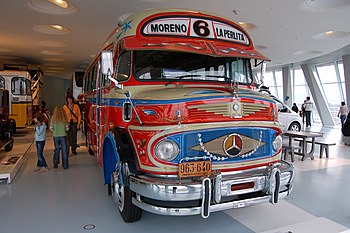Colectivos in Argentina
Colectivos were buses on the chassis of passenger cars or trucks for local public transport in Argentina. These were particularly well known in Buenos Aires and are part of the tradition there. Although modern buses are in operation in Buenos Aires today, the appearance of which has nothing in common with the classic Colectivos, but the name has remained. In the other countries of South America, the name Colectivo is now the common name for shared taxis .
history
When a Colectivo was first used on September 24, 1928, it was still a minibus made from a converted automobile chassis , a Chevrolet Double Phaeton. From 1950, trucks were converted into buses. These buses were often decorated with fileteados , which gave them their own charm and added color to the streets of Buenos Aires.
However, the buses were constantly being developed. While the first buses had just five seats, in the 1980s they could carry around 20 passengers. Since 1990, the bus fleet has been modernized with new bus models specially manufactured for the purpose of passenger transport. The achievement of the purpose was certainly improved by it, its own character, as it z. B. have the red biplanes in London , but lost them.
Together with football, sights such as the Obelisk of Buenos Aires or the Tango Argentino , the Colectivo was one of the tourist attractions of Buenos Aires until 1990. The porteños loved him too. A "colectivo historian" stated:
“The colectivo is seen as a source of national pride. The Porteño is as proud of this as it is of the fact that its compatriots invented the ballpoint pen and the dulce de leche , as it is of the fact that its city is home to the longest avenue in the world ( Avenida Rivadavia ) and the widest ( Avenida 9 de Julio ). "( Alejandro Scartaccini : La Evolución Estilística Del Colectivo Urbano Porteño. - accessed on May 6, 2010 (Spanish))
While vehicles from different manufacturers were used in the first 30 years, all Colectivos gradually came from Mercedes-Benz from 1950 to 1990 . In 1987 the El Detalle company first developed a type of bus with the rear engine for Buenos Aires, as it is in use today. Mercedes-Benz responded the following year with the OH-1314 model, which is seen as the “death of the colectivo”. The last classic Colectivo with the model name Mercedes-Benz LO-1114 was assembled in 1989. Manufacturers today are Mercedes-Benz, Detalle, Scania, Volvo, Dimex and Zanello.
Over time, the routes have also become fixed routes with marked stops. Several bus owners teamed up to serve a specific route. Even today, the city of Buenos Aires does not have its own bus company, as we know it from German cities, but cooperates with a large number of small bus operators who operate one or more routes. The different buses can be distinguished by their different color combinations.
Others
One of the most popular soap operas in Argentina was called Un mundo de 20 asientos (A world with 20 seats), the central figure was a colectivero , a bus driver.
See also
Web links
- Transportation Expo 2007 - Photos (Spanish)
Individual evidence
- ↑ www.busarg.com.ar (span.)
